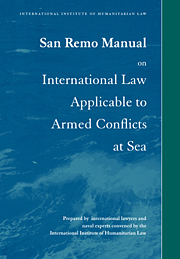 San Remo Manual on International Law Applicable to Armed Conflicts at Sea
San Remo Manual on International Law Applicable to Armed Conflicts at Sea Book contents
- Frontmatter
- Contents
- FOREWORD
- SAN REMO MANUAL
- EXPLANATION
- Introduction
- List of abbreviations
- Part I General provisions
- Part II Regions of operations
- Part III Basic rules and target discrimination
- Part IV Methods and means of warfare at sea
- Part V Measures short of attack: interception, visit, search, diversion and capture
- Part VI Protected persons, medical transports and medical aircraft
- INDEX
Part II - Regions of operations
Published online by Cambridge University Press: 04 August 2010
- Frontmatter
- Contents
- FOREWORD
- SAN REMO MANUAL
- EXPLANATION
- Introduction
- List of abbreviations
- Part I General provisions
- Part II Regions of operations
- Part III Basic rules and target discrimination
- Part IV Methods and means of warfare at sea
- Part V Measures short of attack: interception, visit, search, diversion and capture
- Part VI Protected persons, medical transports and medical aircraft
- INDEX
Summary
Section I Internal waters, territorial sea and archipelagic waters
Preliminary remarks
The paragraphs in this Part, together with paragraphs 10 and 12 of Part I of the Manual, were developed at the Ottawa (1992) session under the Madrid Plan of Action agenda item, Theatre of Operations in Naval Warfare – Different Maritime Areas. A session devoted to this subject was included in the Plan of Action in recognition of the changes that had been wrought in the jurisdictional areas or zones of the ocean since the customary rules for the conduct of armed conflict had crystallised during the nineteenth and early twentieth centuries. These changes were reflected in the 1982 United Nations Convention on the Law of the Sea and included a broadening of the territorial sea from three to twelve nautical miles, the recognition of several new zones denominated as the contiguous zone, the exclusive economic zone, the continental shelf and archipelagic waters, and the recognition of special navigational rights in these zones and through international straits. Although the 1982 United Nations Convention on the Law of the Sea is regarded as providing a peacetime regime for the law of the sea, the areas it defines subject to coastal State sovereignty or the exercise of other forms of national jurisdiction have a significant effect on the exercise of both belligerent and neutral rights during time of armed conflict. As stated by a noted authority on the law of the sea:
To the extent one continues to divide public international law into the two classic categories – the laws of war and the laws of peace – the Convention on the Law of the Sea would doubtlessly fall within the latter category …
- Type
- Chapter
- Information
- San Remo Manual on International Law Applicable to Armed Conflicts at SeaInternational Institute of Humanitarian Law, pp. 93 - 112Publisher: Cambridge University PressPrint publication year: 1995


